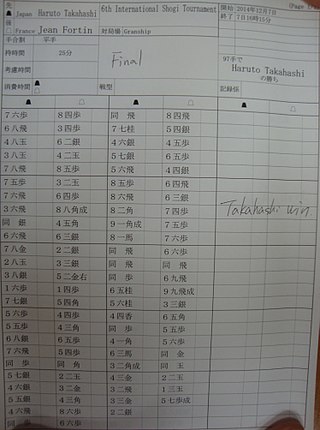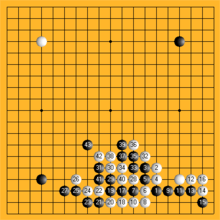
Chess is a board game for two players. It is sometimes called international chess or Western chess to distinguish it from related games such as xiangqi and shogi.

Shogi, also known as Japanese chess, is a strategy board game for two players. It is one of the most popular board games in Japan and is in the same family of games as Western chess, chaturanga, xiangqi, Indian chess, and janggi. Shōgi means general's board game.

Xiangqi, commonly known as Chinese chess or elephant chess, is a strategy board game for two players. It is the most popular board game in China. Xiangqi is in the same family of games as shogi, janggi, Western chess, chaturanga, and Indian chess. Besides China and areas with significant ethnic Chinese communities, this game is also a popular pastime in Vietnam, where it is known as cờ tướng, literally 'General's chess'.

A chessboard is a game board used to play chess. It consists of 64 squares, 8 rows by 8 columns, on which the chess pieces are placed. It is square in shape and uses two colours of squares, one light and one dark, in a chequered pattern. During play, the board is oriented such that each player's near-right corner square is a light square.

Algebraic notation is the standard method for recording and describing the moves in a game of chess. It is based on a system of coordinates to uniquely identify each square on the board. It is now almost universally used by books, magazines, newspapers and software, and is the only form of notation recognized by FIDE, the international chess governing body.

Go is an abstract strategy board game for two players in which the aim is to capture more territory than the opponent by fencing off empty space. The game was invented in China more than 2,500 years ago and is believed to be the oldest board game continuously played to the present day. A 2016 survey by the International Go Federation's 75 member nations found that there are over 46 million people worldwide who know how to play Go, and over 20 million current players, the majority of whom live in East Asia.
This glossary of chess explains commonly used terms in chess, in alphabetical order. Some of these terms have their own pages, like fork and pin. For a list of unorthodox chess pieces, see Fairy chess piece; for a list of terms specific to chess problems, see Glossary of chess problems; for a list of named opening lines, see List of chess openings; for a list of chess-related games, see List of chess variants; for a list of terms general to board games, see Glossary of board games.
Stalemate is a situation in chess where the player whose turn it is to move is not in check and has no legal move. Stalemate results in a draw. During the endgame, stalemate is a resource that can enable the player with the inferior position to draw the game rather than lose. In more complex positions, stalemate is much rarer, usually taking the form of a swindle that succeeds only if the superior side is inattentive. Stalemate is also a common theme in endgame studies and other chess problems.

Checkmate is any game position in chess and other chess-like games in which a player's king is in check and there is no possible escape. Checkmating the opponent wins the game.

Tori shōgi is a variant of shogi, which was invented by Toyota Genryu in 1799 despite being traditionally attributed to his master Ōhashi Sōei. It was first published in 1828 and again in 1833. The game is played on a 7×7 board and uses the drop rule; it is the only traditional shogi variant, possibly besides wa shogi, to do so. This is one of the more popular shogi variants. There were tournaments in London and Royston in the 1990s and early 2000s.
Chess notation systems are used to record either the moves made or the position of the pieces in a game of chess. Chess notation is used in chess literature, and by players keeping a record of an ongoing game. The earliest systems of notation used lengthy narratives to describe each move; these gradually evolved into more compact notation systems. Algebraic notation is now the accepted international standard, with several variants. Descriptive chess notation was used in English- and Spanish-language literature until the late 20th century, but is now obsolescent. Portable Game Notation (PGN) is a text file format based on English algebraic notation which can be processed by most chess software. Other notation systems include ICCF numeric notation, used for international correspondence chess, and systems for transmission using Morse code over telegraph or radio. The standard system for recording chess positions is Forsyth–Edwards Notation (FEN).
Heian dai shogi is an early large board variant of shogi as it was played in the Heian period. The same 12th century document which describes the Heian form of shogi also describes this variant. Unfortunately, this description does not give enough information to actually play the game, but this has not stopped people from attempting to reconstruct this early form of shogi. A fairly complete and playable reconstruction is outlined here.
Dai shogi or Kamakura dai shogi (鎌倉大将棋) is a board game native to Japan. It derived from Heian era shogi, and is similar to standard shogi in its rules and game play. Dai shogi is only one of several large board shogi variants. Its name means large shogi, from a time when there were three sizes of shogi games. Early versions of dai shogi can be traced back to the Kamakura period, from about AD 1230. It was the historical basis for the later, much more popular variant chu shogi, which shrinks the board and removes the weakest pieces.

Kō shōgi is a large-board variant of shogi, or Japanese chess. The game dates back to the turn of the 18th century and is based on xiangqi and go as well as shogi. Credit for its invention has been given to Confucian scholar Ogyū Sorai (1666–1728), who had also described the rules of the game in his book, Kōshōgifu (廣象棋譜).
In chess, a fortress is an endgame drawing technique in which the side behind in material sets up a zone of protection that the opponent cannot penetrate. This might involve keeping the enemy king out of one's position, or a zone the enemy cannot force one out of. An elementary fortress is a theoretically drawn position with reduced material in which a passive defense will maintain the draw.

Professional Go handicaps were a system developed in Japan, in the Edo period, for handicapping professional players of the game of Go against each other. With the abolition of the Oteai system, which from the 1920s had used some handicap games to determine the Go ranking of professional players, this system has become obsolete. It is now completely superseded by the use of komidashi. Knowledge of it is required to understand the conditions of play in historical Go matches, particularly the jubango that died out around 1960.
The rook and bishop versus rook endgame is a chess endgame where one player has just a king, a rook, and a bishop, and the other player has just a king and a rook. This combination of material is one of the most common pawnless chess endgames. It is generally a theoretical draw, but the rook and bishop have good winning chances in practice because the defense is difficult. Ulf Andersson won the position twice within a year, once against a grandmaster and once against a candidate master; and grandmaster Keith Arkell has won it 27 times out of 27. In positions that have a forced win, up to 59 moves are required. Tony Kosten has seen the endgame many times in master games, with the stronger side almost always winning. Pal Benko called this the "headache ending." David Howell observed, "Especially below elite grandmaster level, this is one of the hardest endgames to draw."

A board game record is a game record for a board game.

Shogi notation is the set of various abbreviatory notational systems used to describe the piece movements of a shogi game record or the positions of pieces on a shogi board.











